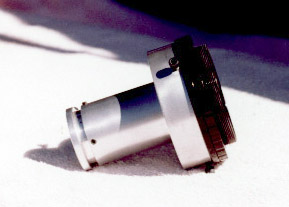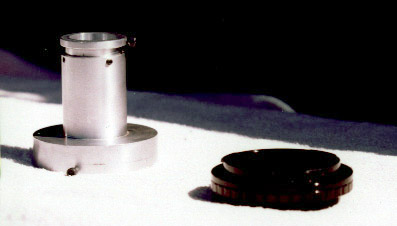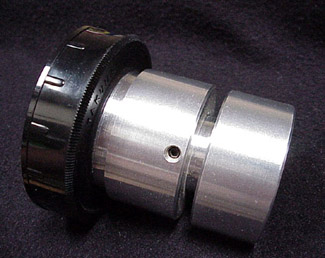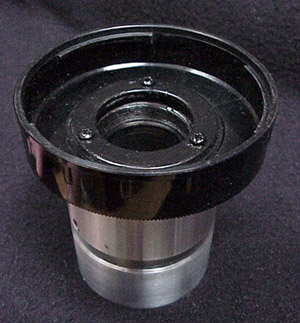One of the seemingly simple problems of astrophotography
is to focus the camera. But focusing on a dim point
source is much harder than it sounds!
There are several methods used in astrophotography:
- Ground glass focusing with a magnifier as
commonly seen on standard camera bodies supplemented
with a focusing magnifier or microscope (10x or greater).
- Aerial focusing with a short focal length eyepiece
as employed with the Taurus astrocamera system.
- Knife edge (or Ronchi grating) focusing which uses
a sharp edged mask to cut the light cone of a point
source. The Ronchi grating serves to
provide convenience by creating multiple parallel
knife edges.
Knife Edge Focusing
Of these 3 methods, the last is generally accepted to be
the most accurate method of assuring focus. The way this
works is that when the knife edge is cutting the light
cone of a point source at the exact focus, if your eye
is positioned behind the focus point in the diverging
light cone, the source's light will be extinguished
suddenly. If the knife edge is inside or outside the
focal point, the light source will gradually be
extinguished as the knife edge cuts across the light
cone.
In practice, one way to implement this is to use two
compatible camera bodies - one being used to hold the
film for photos, and the other used empty, just to
supply the focal plane surface for the knife edge or
Ronchi grating. The scope is focused using the empty
camera body, then it is replaced with the other body for
shooting a photo.
The other implementation is to buy or make a focusing
device which provides a knife edge focusing reference
surface at the same place as the film plane in the
camera. Generally, the procedure is to knife edge focus
the empty camera body to insure that the scope is
accurately focused, then replace the camera with the
focusing device and adjust it until it also indicates
exact focus. Once this is done, the focusing device is
locked so that it can be used to focus the scope once
the camera has been loaded with film.
Generally these knife edge (or Ronchi) focusing devices
can be purchased for 35mm cameras, but for medium format
or larger cameras, they need to be custom made. Below
are two custom implementations for the Pentax 67 camera:

|
|
At left and also immediately below is a
custom-machined focuser belonging to Jim
Janusz. It is designed to thread into an AP
2.7" focuser (or 4" focuser via an adapter),
thus circumventing the problem of making a
coupler compatible with the camera being used.
Jim writes:
|
|
My usual procedure is to put the camera on and
center a star. Then I focus the camera by eye
and move it slightly out of focus in a known
direction, (out) then I remove the camera and
flattener and replace it with the adapter
setup. I knife edge on that and I'm focused.
Once or twice a year I knife edge on the camera
rails and then check the adapter setup, it has
always been right on since I first set it. Then
I never use the camera, only the adapter.

|
Below is a focuser I bought which was made by Mark Park
(OCA) for a Pentax 67. It differs from Jim's focuser in
that Mark's focuser has a coupler with the Pentax
bayonet mount which makes it easy to put on in place of
the camera, and can be used on any scope with a Pentax
67 adapter. This is an advantage for me as I will use
it sometimes on a C11 with a Lumicon Giant Easy Guider,
and sometimes on an AP refractor. This focuser can
also be used on a Pentax lens to determine the exact
focus point, which is not necessarily at the infinity
focus mark.

|
|
Note that Mark adapted a 35mm focuser
for use with a Pentax 67 by using the endcap
for a Pentax lens. This endcap has the
proper bayonet coupling to replace the
camera body. Although it is plastic, it
is stiff plastic, plus it is reinforced on the
inside of the cap with a metal ring (see
photo below).
|
|
The basic design is the same as Jim's. Two
pieces can move relative to each other and then
locked into place once the focal point has been
calibrated to the camera back.
|
|
Because of the difficulty of sighting directly
through the focuser for knife edge focusing,
Mark told me that once he calibrated it against
the camera back, he only used it to verify that
he was achieving good focus with his normal
ground glass focusing. In his case he was
using an eyepiece turned backwards as his
focusing magnifier.
|
|

|
Many thanks to Jim Janusz for providing photos of his focuser
and to both Jim and Mark Park for relating their
focusing techniques to me.





